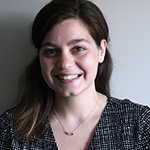What Do Statisticians Like to Do When They Are Not Being Statisticians?

From left: Birthplaces of President John Adams (foreground) and President John Quincy Adams (background), in Braintree, Massachusetts; President Lyndon B. Johnson’s birthplace, near Stonewall, Texas; and President Bill Clinton’s first home in Hope, Arkansas. (Photos by Amy Nussbaum)
This column focuses on what statisticians do when they are not being statisticians. If you would like to share your pastime with readers, please email Megan Murphy, Amstat News managing editor.
Who are you, and what is your statistics position?
My name is Amy Nussbaum and I am the science policy fellow at the American Statistical Association.
Tell us about what you like to do for fun when you are not being a statistician.
I’m an amateur historian, specializing in United States presidents. During high school, my mom and I stopped at Abraham Lincoln’s birthplace during a road trip—it is an incredibly peaceful place and we really enjoyed our time there. On various trips over the years, I saw many other birthplaces advertised on the side of the road or near my final destination and I started making a point to visit these sites.

Nussbaum
Ultimately, I’m trying to visit each and every birthplace …. I’m lucky to have friends and family who indulge my hobby! So far, I’ve been to 13 birthplaces in nine states (unfortunately, none so far in Virginia, even though the ASA is headquartered in Alexandria and more presidents have been born here than in any other state). When I’m not traveling to the next site, I’ve been trying to read a biography of each man, as well.
What drew you to this hobby, and what keeps you interested?
Like many other ASA members, I love to learn. This is a great way to take a break from numbers every so often and educate myself on a new topic.
I also feel like it encourages me to visit places I otherwise wouldn’t have seen, especially those in rural areas. Most are commemorated in some way, and many are in beautiful locations and offer tours through the houses.
At first, I thought that the birthplaces might start to look similar after a while, but this endeavor is constantly surprising! By no means do U.S. presidents constitute a random sample of our shared history, but it’s definitely more representative than I thought. I’ve been to New York, the biggest city in the U.S. (Theodore Roosevelt), and I’ve been to towns so tiny I accidentally drove through them before locating my destination (Ronald Reagan). Some presidents are born into high society (such as Howard Taft), and some are born to very poor families (like Andrew Jackson).
There are also quite a few connections with statistics—it always surprises me when one pops up! For example, George Washington ran the first agricultural survey of the United States by writing letters to 40 neighbors and asking about their crop yields. James Madison was one of the first to add questions to the decennial census, since he recognized the importance of data on the education and occupations of U.S. residents. And, of course, who can forget the lessons pollsters learned during the election of Harry S. Truman in 1948?










I like history, too. I built a database of Civil War Medal of Honor winners to get an idea of where the soldiers came from, since place of birth wasn’t recorded for more than 40 percent of the soldiers and probably most of the sailors. Not surprisingly, the 1523 medals awarded for valor are a very representative sample of the soldiers and sailors, correlating very highly with enlistments by state and combat mortalities. There are soldiers from all over the world and even an African American soldier who was born in Mexico (most likely with a Mexican mother) who served in a “white” regiment.
Since Dr. Nussbaum has been to New York City, perhaps she should have also gone up to the town of Kinderhook (population about 8.5k according to the 2010 Census)in the northern part of the state.
Why? Because the 8th President and the first US-born one was born there. But even more relevant to the ASA, he is the answer to the good trivia question, “Which is the President of the United States who was a member of the ASA?” [Martin Van Buren]
Now, there’s a connection with statistics…
Number theory, and sometimes a subfield known as probabilistic number theory, that nobody talk about anymore.
These are so fun to read! I am particularly enjoying the comments and connections that we being made. Keep it up folks!
Welcome!
Amstat News is the monthly membership magazine of the American Statistical Association, bringing you news and notices of the ASA, its chapters, its sections, and its members. Other departments in the magazine include announcements and news of upcoming meetings, continuing education courses, and statistics awards.
ASA HOME
Departments
Archives
ADVERTISERS
PROFESSIONAL OPPORTUNITIES
FDA
US Census Bureau
Software
STATA
QUOTABLE
“ My ASA friendships and partnerships are some of my most treasured, especially because the ASA has enabled me to work across many institutional boundaries and
with colleagues from many types of organizations.”
— Mark Daniel Ward
Editorial Staff
Managing Editor
Megan Murphy
Graphic Designers / Production Coordinators
Olivia Brown
Meg Ruyle
Communications Strategist
Val Nirala
Advertising Manager
Christina Bonner
Contributing Staff Members
Kim Gilliam
Contact us
Amstat News
American Statistical Association
732 North Washington Street
Alexandria, VA 22314-1904
(703) 684-1221
www.amstat.org
Address Changes
Amstat News Advertising